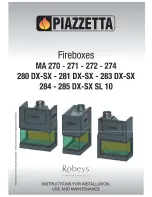
Harman 300i Wood Insert
5
3-90-300101
Harman® • 300i Wood Insert Owner’s Manual_R13 • 2010 -___ • 04/15
Carbon monoxide, referred to as CO, is a colorless, odorless
gas that is produced during combustion of wood and other
fuels.
co fumes are toxic and can be fatal.
The 300i Fireplace Woodburning Insert is a natural draft
system which relies on a properly designed chimney to
remove CO and other combustion by-products from the stove.
Even though this stove is designed to be as safe as possible,
it is important that you
install a CO detector.
This is true for
oil, gas, or coal burning products as well.
CO is not specifically heavier or lighter than air. Therefore,
it is best to install the detector at table top level rather than
on the ceiling like a smoke detector.
CO detectors are very sensitive and may sound an alarm
for fumes other than CO or CO from sources other than the
stove such as car or lawn mower exhaust.
If the alarm sounds
1. Increase ventilation by opening windows or doors.
2. Make sure the stove doors and lid are closed and latched.
3. Check stove for smoking or puffing condition. Open by-
pass and increase air-flow to firebox, if needed.
4. Check chimney for possible blockage or down-draft.
5. Check for false alarm.
safety notIce: If thIs applIance Is not properly
Installed, operated and MaIntaIned, a hoUse
fIre May resUlt. for yoUr safety, follow
INSTALLATION DIRECTIONS. CONTACT LOCAL
bUILDINg OR FIRE OFFICIALS AbOUT RESTRICTIONS
AND INSTALLATION INSpECTION REQUIREMENTS IN
yoUr area.
fire safety
Maintain the designated clearances to combustibles.
Insulation must not touch the chimney. You must maintain
the designated air space around the chimney. This space
around a chimney is necessary to allow natural heat
removal from the area. Insulation in this space will cause a
heat buildup, which may ignite wood framing.
note: clearances may only be reduced by means
approved by the regulatory authority having jurisdiction.
To provide reasonable fire safety, the following should be
given serious consideration:
1.
Install at least one smoke detector on each floor of your
home. Detectors should be located away from the heating
appliance and close to sleeping areas. Follow the smoke
detector manufacturer's placement and installation
instructions, and be sure to maintain regularly.
2.
A conveniently located Class A fire extinguisher to
contend with small fires resulting from burning embers.
3. A practiced evacuation plan, consisting of at least two
escape routes.
4.
A plan to deal with a chimney fire as follows:
In the event of a chimney fire:
a. Evacuate the house immediately.
b. Notify Fire Department.
c. Never apply water to a suspected chimney fire.
Serious damage could occur.






































